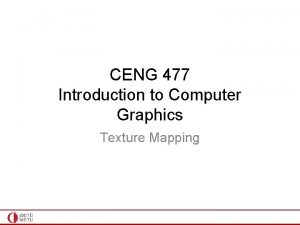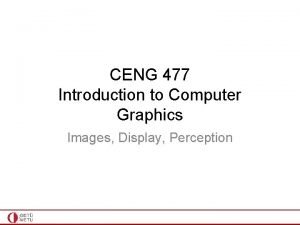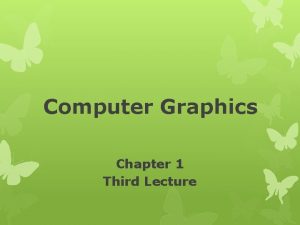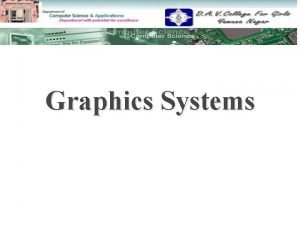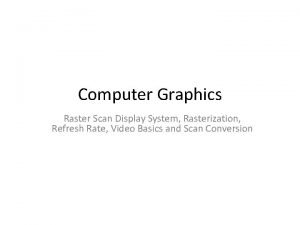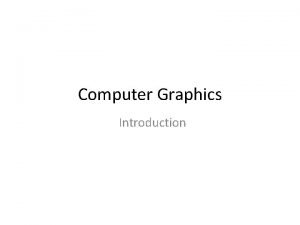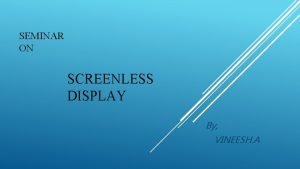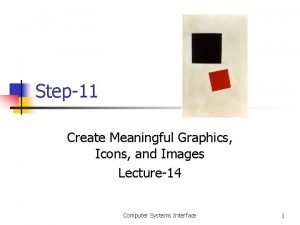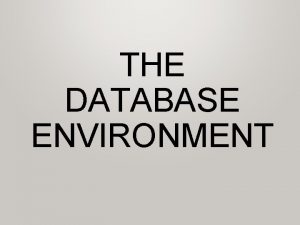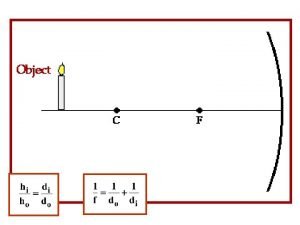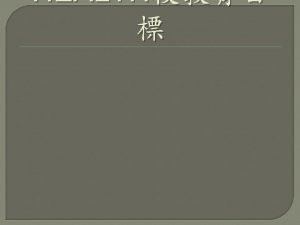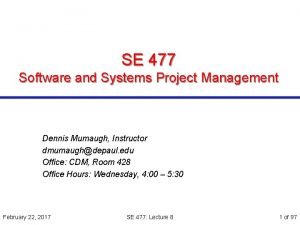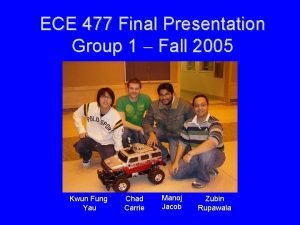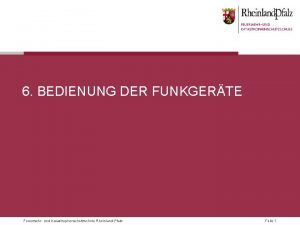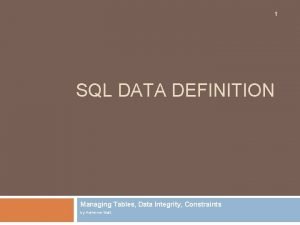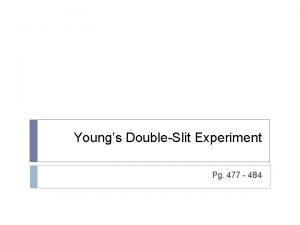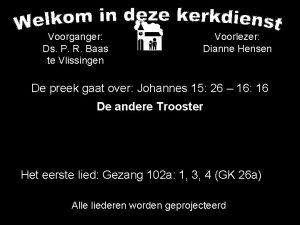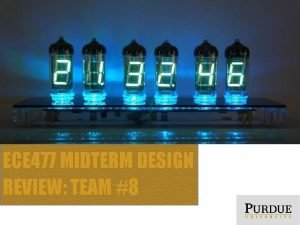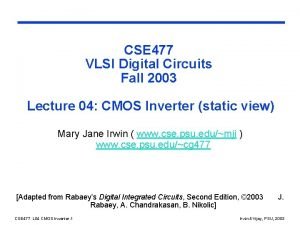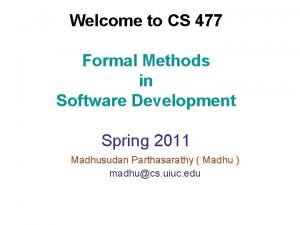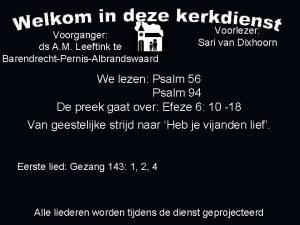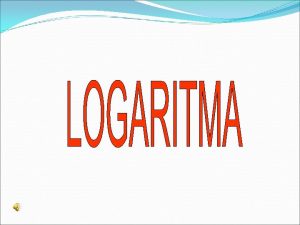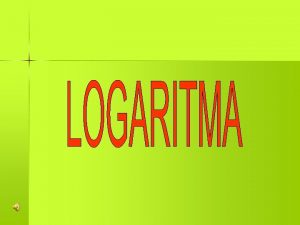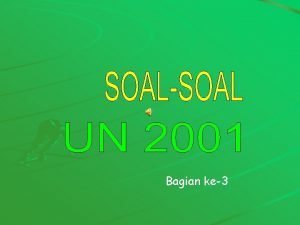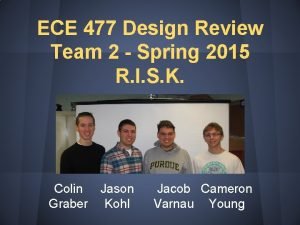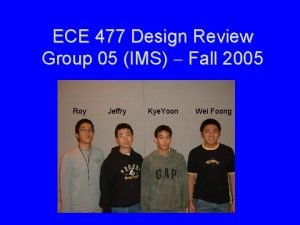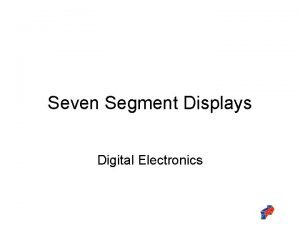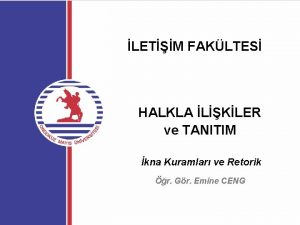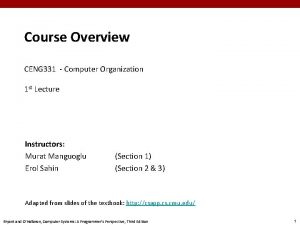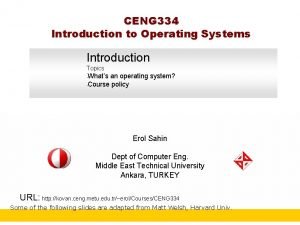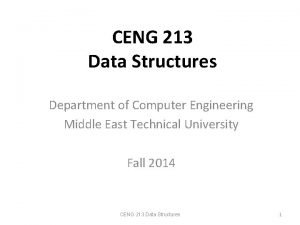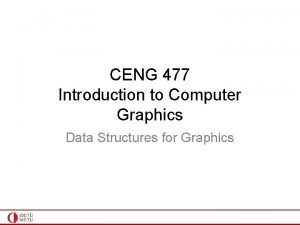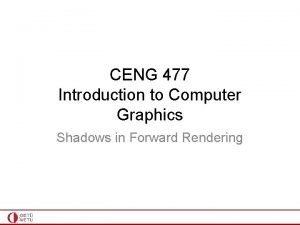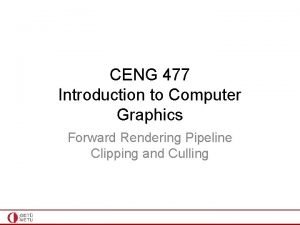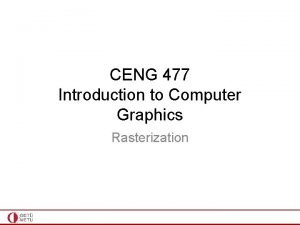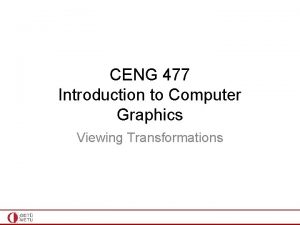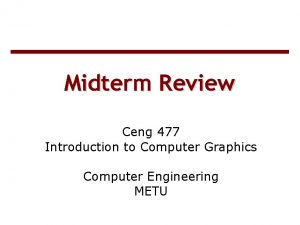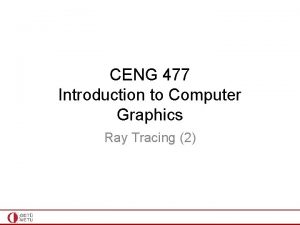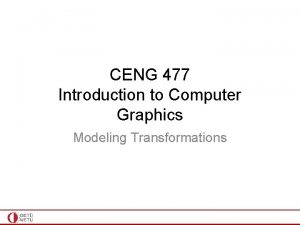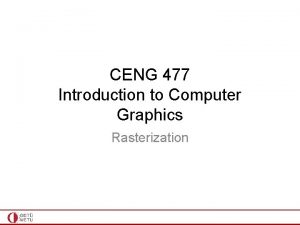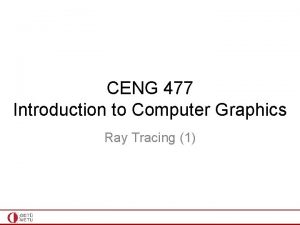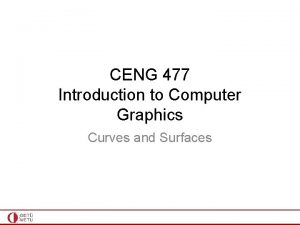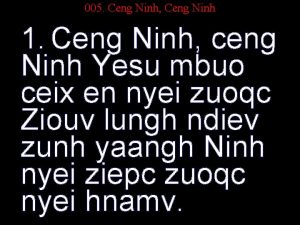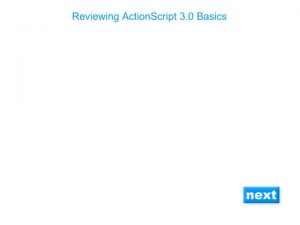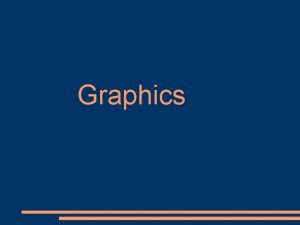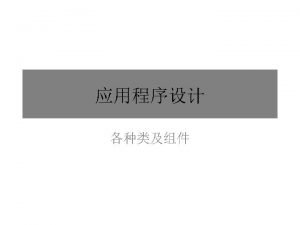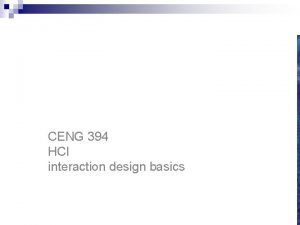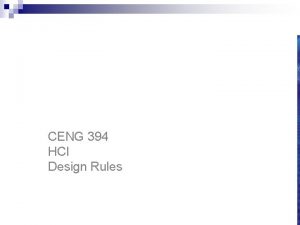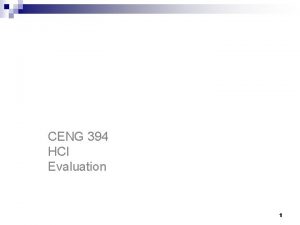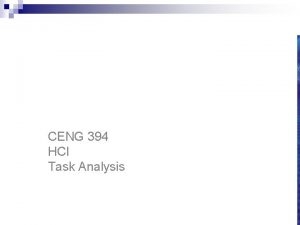CENG 477 Introduction to Computer Graphics Images Display














































- Slides: 46

CENG 477 Introduction to Computer Graphics Images, Display, Perception

Pipeline Recap CENG 477 – Computer Graphics 2

Display Hardware • Video display devices – – Cathode Ray Tube (CRT) Liquid Crystal Display (LCD) Light-emitting Diodes (LED) https: //www. youtube. com/watch? v=_O-2 D 5 ryb 2 A • Hard-copy devices – Ink-jet printer – Laser printer – Pen plotter (3 D printer idea) CENG 477 – Computer Graphics 3

Raster Displays • Rectangular array (raster) of picture elements (pixels). • The goal of CG is to populate this array with the correct color values such that the final image conveys the desired look. CENG 477 – Computer Graphics 4

Raster Displays • Rectangular array (raster) of picture elements (pixels). CENG 477 – Computer Graphics 5

Raster Displays • Frame buffer, double buffering CENG 477 – Computer Graphics 6

Raster Displays • Generated images are sent to a display devices (CRT, LCD) through the video driver CENG 477 – Computer Graphics 7

Raster Displays • Most display devices are not linear; i. e. , there is a nonlinear relationship between the input voltage and the output luminance – Luminance is a photometric measure of the luminous intensity per unit area of light travelling in a given direction //brightness CENG 477 – Computer Graphics 8

Raster Displays • This means that if you double a pixel value (i. e. , the input voltage), you do not get twice the luminance CENG 477 – Computer Graphics 9

Raster Displays • This means that if you double a pixel value (i. e. , the input voltage), you do not get twice the luminance • The relationship is generally modeled as: – c contract, b brightness, gamma of the display device • If we know gamma, we can correct our images before sending to the display device so that they appear correct to the viewer CENG 477 – Computer Graphics 10

Raster Displays • If we know gamma, we can correct our images before sending to the display device so that they appear correct to the viewer I: input intensity CENG 477 – Computer Graphics 11

Raster Displays • With and without CENG 477 – Computer Graphics gamma correction: 12

Raster Displays • To estimate gamma of the display device – Find the patch which matches in intensity to the blended value of the black-and-white stripes – Read out the corresponding pixel value, Z, and solve for CENG 477 – Computer Graphics 13

Image • An image is a 2 D rectilinear array of pixels Continuous image Digital image CENG 477 – Computer Graphics 14

Image • Pixels are samples from continuous function – Photoreceptors in eye – CCD cells in digital camera – Rays in virtual camera CENG 477 – Computer Graphics 15

Image • Sampling brings errors – Errors due to limited intensity resolution //quantization – Errors due to limited spatial resolution //aliasing Sampling Reconstruction (errors introduced) CENG 477 – Computer Graphics 16

Image • Quantization – Images with decreasing bits per pixel: (aka uniform quantization) – How many bits for a color image? CENG 477 – Computer Graphics 17

Image • Quantization – A color image (24 bpp) – How many bits for a color image? CENG 477 – Computer Graphics 18

Image • Aliasing – Use the average of neighboring intensities per pixel Aliased: Antialiased: CENG 477 – Computer Graphics 19

Image • More image processing tools – Filtering • Blurring • Noise reduction – Mean and median filters that reduce the noise, e. g. , salt-pepper noise: – Warping • Scaling • Rotating • Deforming CENG 477 – Computer Graphics 20

Image • More image processing tools – Filtering • Blurring • Noise reduction – Mean and median filters that reduce the noise, e. g. , salt-pepper noise: – Warping • Scaling • Rotating • Deforming CENG 477 – Computer Graphics 21

Image • More image processing tools – Filtering • Blurring • Noise reduction – Mean and median filters that reduce the noise, e. g. , salt-pepper noise: – Warping • Scaling • Rotating • Deforming CENG 477 – Computer Graphics 22

Image • More image processing tools – Filtering • Blurring • Noise reduction – Mean and median filters that reduce the noise, e. g. , salt-pepper noise: – Warping • Scaling • Rotating • Deforming CENG 477 – Computer Graphics 23

Image • More image processing tools – Filtering • Blurring • Noise reduction – Mean and median filters that reduce the noise, e. g. , salt-pepper noise: – Why works? – Warping • Scaling • Rotating • Deforming CENG 477 – Computer Graphics 24

Image • More image processing tools – Filtering • Blurring • Noise reduction – Mean and median filters that reduce the noise, e. g. , salt-pepper noise: – Warping • Scaling • Rotating • Deforming CENG 477 – Computer Graphics 25

Image • More image processing tools – Filtering • Blurring • Edge detection – Filter that finds differences b/w neighbor pixels (high gradient = edge) – Warping • Scaling • Rotating • Deforming CENG 477 – Computer Graphics 26

Image • More image processing tools – Filtering • Blurring • Sharpening – Edge/gradient image g(x, y) = f(x, y) – fsmooth(x, y). – fsharp(x, y) = f(x, y) + k * g(x, y) – Warping • Scaling • Rotating • Deforming CENG 477 – Computer Graphics 27

Image • More image processing tools – Filtering • Blurring • Sharpening – Edge/gradient image g(x, y) = use – fsharp(x, y) = f(x, y) + k * g(x, y) filter directly – Warping • Scaling • Rotating • Deforming CENG 477 – Computer Graphics 28

Image • More image processing tools – Filtering • • Blurring Noise reduction Edge detection Sharpening – Warping • Scaling: • Rotating • Deforming CENG 477 – Computer Graphics 29

Image • More image processing tools – Filtering • • Blurring Noise reduction Edge detection Sharpening – Warping • Scaling • Rotating: • Deforming CENG 477 – Computer Graphics 30

Image • More image processing tools – Filtering • • Blurring Noise reduction Edge detection Sharpening – Warping • Scaling • Rotating • Deforming: Warp CENG 477 – Computer Graphics Fish eye lens 31

Image • More image processing tools – Compositing • Create background image • Create foreground image with blue background • Insert non-blue foreground pixels into background CENG 477 – Computer Graphics 32

Image • More image processing tools – Compositing • Blues work as transparent pixels (alpha=0), others opaque (alpha=1) • Apply weighted alpha for alpha matting (semi-transparent) – Color = (1 -alpha)*foreground. Color + alpha*background. Color • Pixels with alpha channel: (r, g, b, alpha) CENG 477 – Computer Graphics 33

Image • Image formats – Typically images are represented with 8 -bits per color channel giving rise to 24 -bit pixels – Images may be displayed directly (by sending it to the video card) or may be stored in a standard format (for offline viewing) – There are hundreds of image formats, perhaps JPEG being the most commonly used – In this class, we’ll use a simple file format called PPM to store our images (for ray tracing) CENG 477 – Computer Graphics 34

Image • PPM format – PPM is a very simple interleaved image format – It has two flavors namely text and binary and we will use the text version for further simplicity – Example: CENG 477 – Computer Graphics 35

Image • PPM format – Note that PPM is hugely inefficient as everything is stored as uncompressed ascii characters – What would be the size of an 18 MP PPM image file? – 18 × 1024 × 3. 57/(1024 × 1024) MB ≈ 192 MB – The last × 3. 57 represents the expected value of the number of bytes that each component will occupy: • (10 × 1 + 90 × 2 + 156 × 3)/256 + 1 where the last +1 represents the space occupied by white space (or the newline character between rows) CENG 477 – Computer Graphics 36

Image • PPM format – Note that PPM is hugely inefficient as everything is stored as uncompressed ascii characters – What would be the size of an 18 MP PPM image file? – If we had a binary file, the file size would be 18 × 1024 × 3/(1024 × 1024) MB ≈ 54 MB as each component will be saved as a single byte and white spaces would not be stored – This is still lots of disk space for a single image – More efficient file formats such as JPEG, TIFF, and PNG occupy much less space due to compression CENG 477 – Computer Graphics 37

Image • Lossy vs. lossless formats – Some image formats are lossy meaning that they cannot reconstruct the original signal exactly – JPEG is a lossy file format (however, depending on the compression quality visually perceiving errors may be impossible) – TIFF can be both lossy and lossless depending on the selected options – PPM and PNG are lossless – Let’s convert our simple. ppm to JPEG to observe the difference CENG 477 – Computer Graphics 38

Image • JPEG format – Discrete Cosine Transform on each 8 x 8 block of the image – Ignore small coefficients CENG 477 – Computer Graphics 39

Image • JPEG format – Discrete Cosine Transform on each 8 x 8 block of the image – Ignore small coefficients, quantize CENG 477 – Computer Graphics 40

Image • JPEG format – Discrete Cosine Transform on each 8 x 8 block of the image – Ignore small coefficients, quantize, apply Huffman coding CENG 477 – Computer Graphics 41

Image • JPEG format – Discrete Cosine Transform on each 8 x 8 block of the image – Ignore small coefficients, quantize, apply Huffman coding – See https: //youtu. be/Q 2 a. Eze. MDHMA for details CENG 477 – Computer Graphics 42

Image • Lossy vs. lossless formats CENG 477 – Computer Graphics 43

Image • A JPEG with different quality settings CENG 477 – Computer Graphics 44

Perception • Human eye can distinguish about 10 M different colors. CENG 477 – Computer Graphics 45

Perception • Electromagnetic spectrum. – Bees and many other insects can detect ultraviolet light, which helps them to find nectar in flowers. – Bees’ visible spectrum, however, ends at about 590 nm, just before the orange wavelengths start. – Birds, however, can see some red wavelengths, although not as far into the light spectrum as humans. – Human spectrum: red (700 nm) to violet (400 nm). – Goldfishes can see ultraviolet light (10 nm). CENG 477 – Computer Graphics 46
 Ceng 477
Ceng 477 Ceng 477
Ceng 477 Video display devices
Video display devices Advantages of raster scan display
Advantages of raster scan display Programming raster display system in computer graphics
Programming raster display system in computer graphics Plasma panel display in computer graphics
Plasma panel display in computer graphics Focusing system in crt
Focusing system in crt Display technology in computer graphics
Display technology in computer graphics Raster scan display system in computer graphics
Raster scan display system in computer graphics Graphics monitors and workstations
Graphics monitors and workstations Graphics hardware in computer graphics ppt
Graphics hardware in computer graphics ppt Raster scan display and vector scan display
Raster scan display and vector scan display Circle drawing algorithm in computer graphics ppt
Circle drawing algorithm in computer graphics ppt Conceptual framework for interactive graphics
Conceptual framework for interactive graphics Screenless display seminar ppt
Screenless display seminar ppt Zeta phi beta membership intake process manual
Zeta phi beta membership intake process manual Nnn icons
Nnn icons Facts, text, graphics, images, etc.
Facts, text, graphics, images, etc. Virtual vs real image
Virtual vs real image Real images vs virtual images
Real images vs virtual images Mail @ malaysia.images.search.yahoo.com
Mail @ malaysia.images.search.yahoo.com How to save images on google images
How to save images on google images Https://tw.images.search.yahoo.com/images/view
Https://tw.images.search.yahoo.com/images/view Sw 477
Sw 477 Log 50-log 5+2 log 2
Log 50-log 5+2 log 2 Sr0fx
Sr0fx Sepura *477
Sepura *477 Biba n 483 ddl
Biba n 483 ddl Experiment 484
Experiment 484 Liedboek 477
Liedboek 477 Ece 477
Ece 477 Vol and voh
Vol and voh Logic solver
Logic solver Opwekking 477
Opwekking 477 Jika log 2 = 0 301 dan log 3 = 0 477
Jika log 2 = 0 301 dan log 3 = 0 477 Jika 27 log 5 = p maka 25 log 3 + 243 log akar 5
Jika 27 log 5 = p maka 25 log 3 + 243 log akar 5 Jika log 2 = 0 301 nilai log 32 =
Jika log 2 = 0 301 nilai log 32 = Jika log 3=0 477 dan log 5=0 699 maka log 45 adalah
Jika log 3=0 477 dan log 5=0 699 maka log 45 adalah Ece 477
Ece 477 Ece 477
Ece 477 Common anode ssd
Common anode ssd Emine ceng
Emine ceng Ceng考牌
Ceng考牌 Ceng334
Ceng334 Ceng application example
Ceng application example Ceng 334
Ceng 334 Cow.ceng.metu.edu tr
Cow.ceng.metu.edu tr
